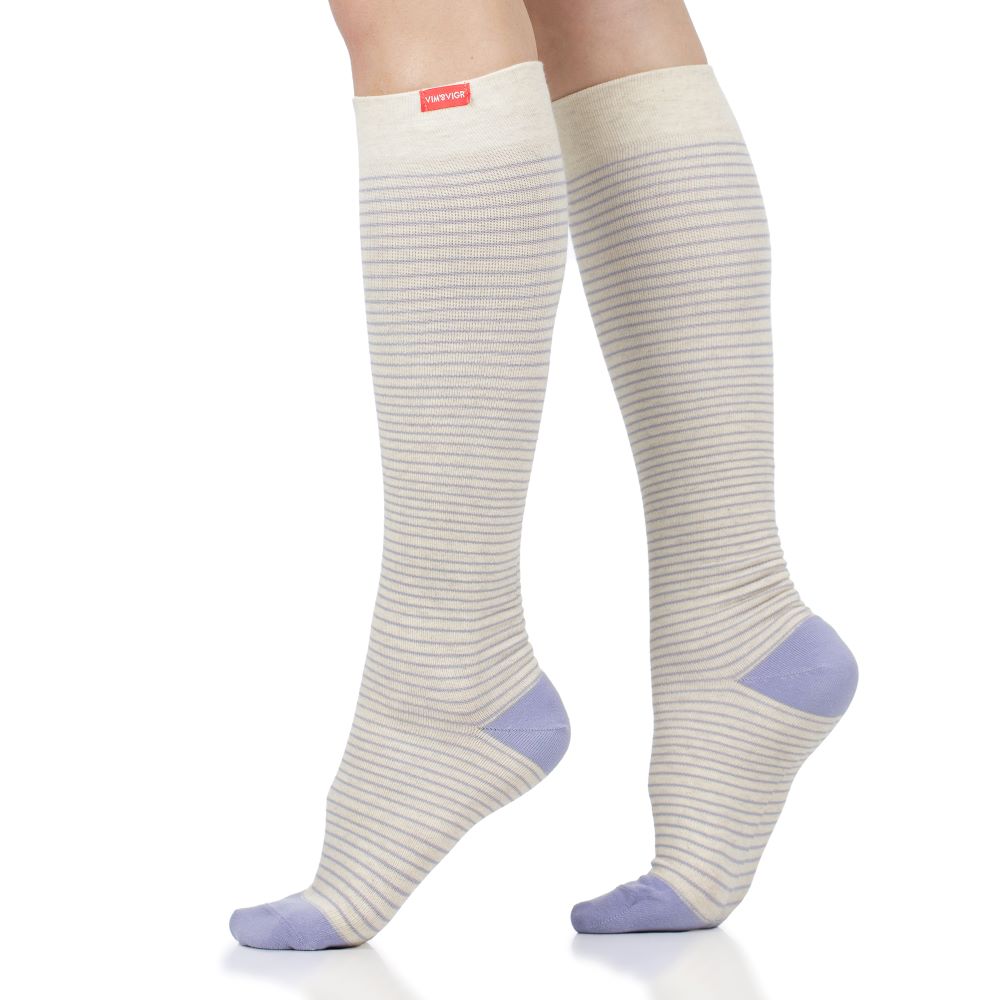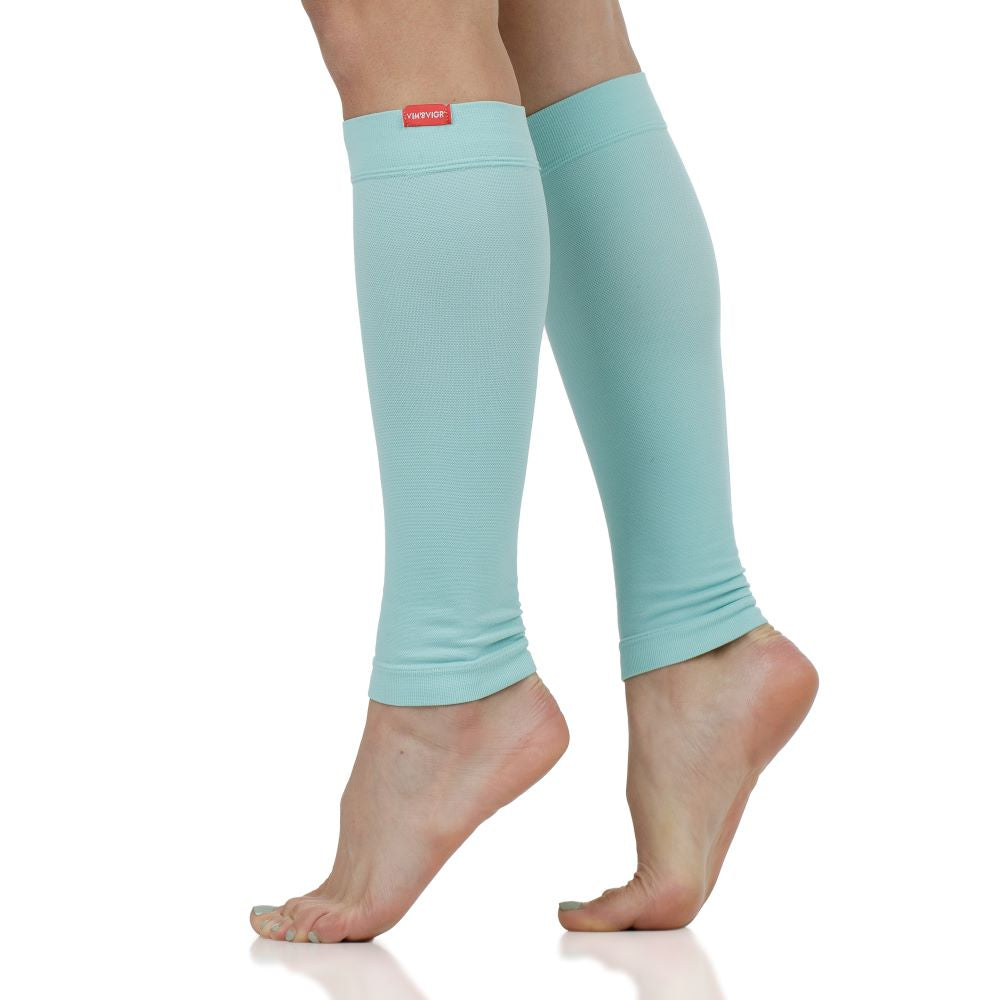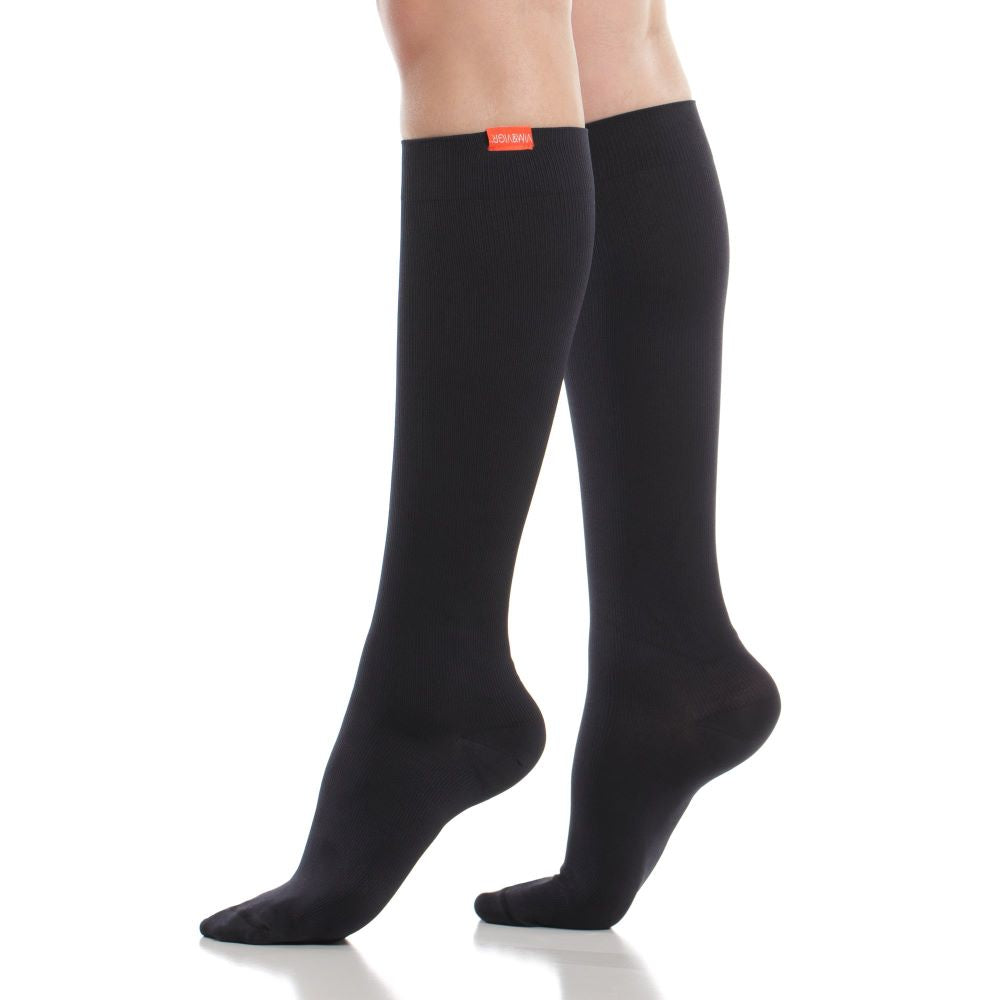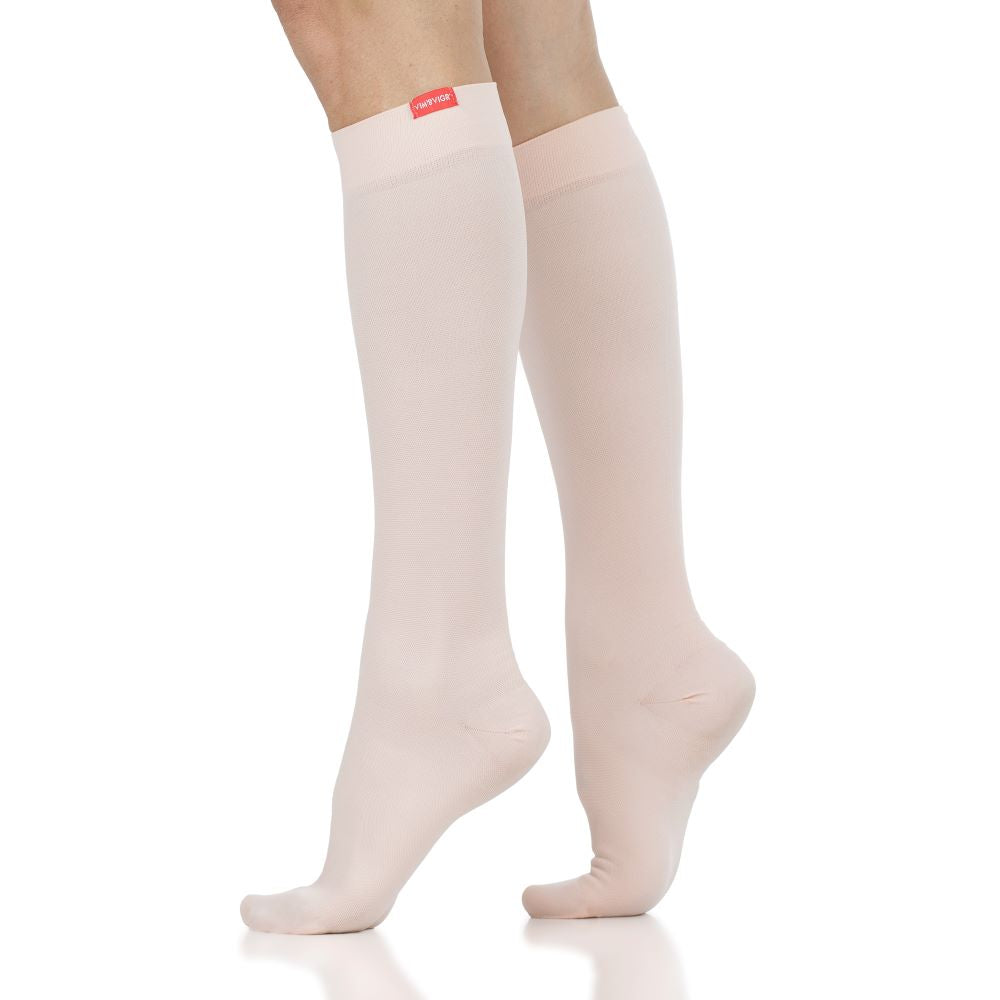Why Do Compression Socks Have Open Toes?
You might have stumbled across a pair of compression socks and realized that they are missing the toe pocket and thought “this must be a mistake!” However, this is no mistake, and thousands of compression sock wearers prefer to wear open toe compression socks throughout the day. There are many reasons for this, including sensory preferences, different shoe types, and looking for discreet compression sock options for the summer.
Why Do Compression Socks Have Open Toes?
When we surveyed our customers to see why they wanted an open toe compression sock, we got a couple of different answers. A recurring theme however was our customers wanted to wear a compression garment, that still compressed the arch and ankle, with their summer sandals. For a long time, compression sleeves were the summer standard with compression, however, since they do not compress the arch and ankle, they are not as effective for those who use compression socks for their medical needs.
Ultimately, many compression wearers use open toe compression socks as a tool to reduce swelling without hampering their summer style. The second most common reason for open toe compression socks is for those who have sensory issues. Some people who need compression socks cannot tolerate their toes being encapsulated by a sock. But, for medical reasons, they need more compression than a sleeve can provide.
The Benefits of Open Toe Compression Socks
The benefits of open toe compression socks are similar to the benefits of closed toe compression socks. There are many unexpected benefits of compression socks outside of the benefits you may already know about.
ENERGIZE YOUR LEGS
Graduated compressions' whole purpose is to increase circulation, thus improving energy levels in the body. When you sit all day at a desk or stand all day on your feet, you make it harder on your body to circulate blood. Compression socks help your body to circulate more efficiently and increase energy throughout the day.
REDUCE SWELLING AND FLUID RETENTION
Another benefit of improving circulation is decreasing swelling and fluid retention. This fluid retention is medically referred to as Edema, and Doctors often prescribe compression socks for Edema. The graduated compression that we discussed before helps to support your veins. With Edema, poor circulation leads to fluids leaking from your veins into your muscles, causing swelling.
ALLEVIATE ACHINESS AND HEAVINESS
Increased circulation decreases swelling and increases blood flow, this reduces the feeling of heavy and achy legs. When your ankles and feet swell, that is their cry for help. Compression socks help to get you moving comfortably again. Plus, that gentle hug on your legs just feels good.
SUPPORT MUSCLE RECOVERY
Many athletes are no stranger to compression, in the “RICE” recovery method used by many coaches, the C is for compression! Some 65 percent of runners suffer from an injury at least once a year. The constant pounding can lead to ankle soreness, shin splints, and inflammation. Compression socks reduce the stress on your muscles during a workout or exercise and help your legs recover quicker, which is why they’re increasingly popular on a race’s starting line. They also make circulation more efficient, which can reduce muscle fatigue during a run or race. As part of a recovery strategy, compression socks also stop lactic acid from building up in tired muscles, which is why they’re also making their presence felt in cycling as a way to soothe exhausted calf muscles.
IMPROVED ATHLETIC PERFORMANCE
As you can imagine, if you keep your legs free of injury, your athletic performance can improve! While being sidelined due to an injury is not the end of the world, it is difficult to train at the highest level when injured. Compression socks help to prevent injury from happening, allowing for better quality training.
BETTER SLEEP QUALITY
Most people who wear compression socks roll them on during the daytime and remove them before going to bed. That’s because the socks work hardest when you’re standing but are less necessary once you’re lying down and your circulation is no longer wrestling with gravity. There are, however, some unexpected cases where compression socks at night can improve sleep. Studies have shown that compression stockings can have a modest effect on reducing sleep apnea and may also reduce the symptoms of restless leg syndrome, which can otherwise ruin a good night’s sleep. Check with a medical professional if this sounds like you since you may need a medical-grade sock with a compression level around 20 to 30 mmHg.
IMPROVED CIRCULATION FOR THOSE WHO SIT OR STAND ALL DAY
When sitting or standing for long periods of time, you allow blood to pool in your legs and ankles. Graduated compression socks, like ours, are tightest at the ankle and push blood up and through the leg even while sitting. This compression is what allows blood to not get trapped in the legs. Improved circulation is one of the many benefits of compression socks.
REDUCE AND TREAT VARICOSE VEINS
Venous insufficiency is the underlying health condition that is linked to having varicose veins. It means that your veins are unable to send blood from the limbs back to the heart, causing it to pool in the veins in your legs. This is usually caused by weakened or damaged valves within the veins.
With all the blood stuck in the veins, they become enlarged, stretching from the increased pressure. In time, this weakens the walls of the veins and further damages the valves, leading to varicose veins.
Doctors recommend compression socks for varicose veins because they help blood to circulate throughout the leg.
SUPPORT OVERALL LEG HEALTH
As you may have put together from all the aforementioned benefits, improved circulation has a TON of benefits. Overall, blood pooling in your legs can cause an array of discomfort. Compression socks are often associated with the elderly, but they’re actually beneficial for every age group, and wearing them earlier will only help you more!
RELIEF FROM CHRONIC HEALTH CONDITIONS
Doctors prescribe compression socks for illness such as POTS, EDS, Neuropathy, and so much more. Compression socks help each illness in a different way, and we recommend consulting your doctor for more information. But many of our customers swear by compression socks day in and day out.
“These compression socks are so comfy and the material is really high quality, and along with this versatile design that goes with everything, they're totally worth the cost! I use them for my POTS and they do help me a lot!” - Trisha Tambe
Why Do Anti-Embolism Stockings Have Open Toes?
Before diving into this topic, there is a difference between an anti-embolism stocking (TED Hose) and compression socks. We cover this comparison of TED hose vs. Compression socks in another blog, but this picture sums up the main differences:
As mentioned before, the open toe stocking design allows for discreet wear and allows sandals to be worn with compression socks. It also supports graduated compression through the arch and ankle, where blood tends to pool. Some compression sock wearers have said that putting on open toe compression socks is easier than closed toe compression socks as well.
Who Should Wear Open Toe Compression Socks
Anyone who wears closed toe compression socks, whether it be for comfort, style, or a medical condition, can wear open toe compression socks. The toe box on compression socks does not provide compression typically, so its absence does not affect the usefulness of the sock. Many find it more comfortable to be able to spread and wiggle their toes while wearing compression socks. Many who wear compression socks to bed feel that open toe compression socks are just as comfortable and much more effective.
How to Wear Open Toe Compression Socks
Open toe compression socks are meant to leave your toes free while still compressing your arch and ankle. Putting them on is a lot like putting on a normal pair of compression socks.
- Slip your arm into the sock until your fingers reach the hole that the end. Your palm should be resting in the sock's heel.
- Starting at the cuff, fold the sock over towards your hand until it meets the heel. Make sure to fold the sock onto itself.
- With the sock still inverted, pull it firmly onto your foot. Make sure your toes are securely in the toe hole, and your heel in the heel pocket. Starting with the cuff, gradually roll the sock up.
- Adjust so that your heel is properly positioned in the heel pocket and the cuff sits below the knee. Make sure the cuff is not pulled up too high and do not fold the cuff over.
Open toe compression socks are meant to be worn like normal compression socks – and you can wear them as long as they remain comfortable.
The Best Open Toe Compression Socks
Open toe compression socks are typically worn in the summer months, and by individuals who need to wear compression no matter the season. We kept this in mind when designing our open toe compression socks and made sure to use our cotton fabric in the 20-30 mmHg compression range. Cotton is breathable and great for the heat. Many customers say it is their go to summer compression sock fabric! 20-30 mmHg compression provides firm support that is great for a variety of compression sock wearers such as moderate edema, lymphedema, Deep Vein Thrombosis (DVT), pre and post-surgical applications, moderate spider and varicose veins.
We will be releasing new open toe compression sock designs in the coming months, so join our email list to be the first to know when they drop!
For now shop stylish and functional open toe compression socks online at Vim & Vigr!



















Thanks for all the information. I broke my fiemer in December, and have been in rehab most of the month of January. It was suggested to me by my doctor and I will need compression socks and I had no idea about them. Your page has been quite a helpful information source.
Leave a comment